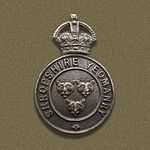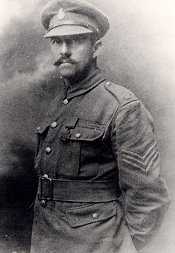Shropshire Yeomanry
| Shropshire Yeomanry | |
|---|---|
 badge of the Shropshire Yeomanry | |
| Active | 1795–present |
| Country |
|
| Branch |
|
| Type | Cavalry |
| Role | Yeomanry |
| Part of | Royal Armoured Corps |
| Engagements |
WORLD WAR I Second Battle of Gaza Third Battle of Gaza Battle of Beersheba Battle of Epehy WORLD WAR II Battle of Sicily Battle of Monte Cassino Gustav Line Hitler Line Gothic Line |
| Battle honours |
South Africa 1900- 1902 World War II No battle honours were awarded. It is tradition within artillery units that the Regiment's guns represent its colours and battle honours.[1] |
The Shropshire Yeomanry was a yeomanry regiment of the British Army, first raised in 1795, which served as a cavalry and dismounted infantry regiment in the First World War and as a cavalry and an artillery regiment in the Second World War, before being amalgamated with the Shropshire Royal Horse Artillery.
In 1969 the regiment was disbanded and replaced by No. 4 Squadron, 35 (South Midland) Signal Regiment (Volunteers) and the Shropshire Yeomanry Cadre, later formed into the Shropshire Yeomanry Squadron of Queen's Own Mercian Yeomanry, then amalgamated into the Royal Mercian and Lancastrian Yeomanry.
History

The Shropshire Yeomanry dates its origins to the French wars of 1793-1815, when volunteer cavalry units were raised throughout the country. They date their origins to the raising of the Wellington Troop in 1795.[2]
From 1814 the units had been clothed and trained as "Dragoons" (mounted infantry). It was to prove a fortunate upbringing because the failure of the Regular Army to contain the Boer forces in the South African Campaign caused the Volunteer Cavalry to be called for overseas service in 1900. Volunteers from the Regiment formed the 13th (Shropshire) Company of the 5th Battalion Imperial Yeomanry.[2] Three contingents of 13/5 served in South Africa, earning the first Shropshire Yeomanry battle-honour, South Africa 1900-1902.[2]
World War I
In accordance with the Territorial and Reserve Forces Act 1907 (7 Edw.7, c.9) which brought the Territorial Force into being, the TF was intended to be a home defence force for service during wartime and members could not be compelled to serve outside the country. However, on the outbreak of war on 4 August 1914, many members volunteered for Imperial Service. Therefore, TF units were split in August and September 1914 into 1st Line (liable for overseas service) and 2nd Line (home service for those unable or unwilling to serve overseas) units. Later, a 3rd Line was formed to act as a reserve, providing trained replacements for the 1st and 2nd Line regiments.[4]
1/1st Shropshire Yeomanry
The 1/1st Shropshire Yeomanry was part of the Welsh Border Mounted Brigade, which in 1914 was attached to the 1st Mounted Division.[4] Then in 1915 they were dismounted and served in the Western Desert as part of the 4th Dismounted Brigade[4] in Egypt and Palestine. Then in 1917, together with the 1/1st Cheshire Yeomanry, they formed the 10th Battalion King's Shropshire Light Infantry (K.S.L.I.), and were attached to the 231st Brigade, 74th (Yeomanry) Division.[4] and were involved in the following battles:
- Second Battle of Gaza
- Third Battle of Gaza
- Battle of Beersheba
- Battle of Epehy
Victoria Cross

The only Victoria Cross awarded to a Shropshire Regiment was won by Sgt. Harold Whitfield of the Shropshire Yeomanry,(10TH K.S.L.I.), for gallantry at Burj-el-Lisaneh in Palestine in 1918.[2]
2/1st Shropshire Yeomanry
The 2/1st Shropshire Yeomanry was formed in 1914 and joined the 2/1st Welsh Border Mounted Brigade.[4] They remained in the United Kingdom until July 1916, when they were converted into a Cyclist unit and moved to Ireland in early 1918.[4][5]
3/1st Shropshire Yeomanry
The 3/1st Shropshire Yeomanry was formed in 1915 as part of a Reserve Cavalry Regiment,[4] and remained in the United Kingdom until they were disbanded in early 1917.[5]
World War II
75th (Shropshire Yeomanry) Medium Regiment, R.A.
On 1 September 1939, the Shropshire Yeomanry was a Horsed Cavalry Regiment, but in 1940, the Regiment lost its horses and converted to artillery. "A" Squadron and H.Q. Squadron formed 101 and 102 Batteries of the 75th Medium Regiment, R.A.[6] On 20 December 1942 the Regiment, equipped with 4.5" howitzers, left Liverpool for Durban and Suez, arriving on 14 April 1943.[6] 101 Battery was re-equipped with 5.5 howitzers, whilst 102 kept its 4.5's.[6] After intensive training, 101 battery moved through the desert to Tripoli, then went to Syracuse in Sicily and saw its first action. 102 Battery arrived in Sicily from Egypt on 7 August.[6] The Regiment served through the Italian campaign, sometimes in support of the 5th Army, sometimes with the 8th Army (at least parof the time with 6 AGRA), and saw action in many notable battles. These included the third battle of Monte Cassino, operations against the Gustav Line and the breakthrough, operations against the Hitler Line, actions at Arezzo and the occupation of Florence and Forlì.[7]
The Regiment went on to serve in the Apennines against the Gothic Line and on to the final offensives of the 8th Army in Spring 1945.[6] The end of the war found the 75th Medium Regiment in defensive positions facing Tito's Yugoslav army in Venezia Giulia.[6]
76th (Shropshire Yeomanry) Medium Regiment, R.A.
After the conversion from Horsed Cavalry to Gunners in 1940, "B" Squadron and "C" Squadron formed the nucleus of the 76th Medium Regiment as 112 and 113 Batteries, and where equipped with Great War 60-pounders, although these were later replaced by 6-in. howitzers. From then until 1942, the Regiment was occupied in intensive training.[6] On 25 August 1942, now equipped with 5.5-in. howitzers, sailed from Gourock-on-Clyde, also by way of Durban, to the Suez Area, arriving in November.[6] In January 1943, the Regiment left Egypt and motored by way of the Sinai Desert along the Trans-Jordan Pipeline to Baghdad to join the Persia and Iraq Force ("Paiforce").[6] In April, they moved to Syria and through a shortage of guns in Tunisia lost its own.[6] In May, more guns arrived and combined operations with further intensive training were carried out in the Suez Canal area. They left the Middle East in December 1943, and landed at Taranto, Italy, by the 9 December. 112 Battery had at this time 5.5-in. howitzers and 113 Battery 4.5's, but shortly after landing 112 lost its guns to another Yeomanry Regiment, receiving 4.5's in exchange.[6] On 15 December 1943 the Regiment moved up to the Sangro battle and took over from its sister-regiment in support of the 8th Army.[6] In February 1944, the Regiment moved across to Cassino and took part in the battles of 16 February to 15 March and the successful capture and break-through of 11 May, and then on to the Hitler Line.[6] The advance now went beyond Rome, with the Regiment supporting the 6th South African Armoured Division up to and including the fight for Florence, except for the Arezzo battle, with 6th Armoured Division.[6] In April 1945, the Regiment again moved across Italy to the east coast to join the final offensive with the 8th Army. After the surrender on 2 May 1945 the Regiment saw further action on the road to Austria, but, like its sister-regiment, was watching Tito near Trieste on V.E. Day.[6]
Post World War II
Since 1947, the Regiment has been equipped with Tanks, Armoured Cars, Scout Cars and Land Rovers, whilst under command of the Royal Armoured Corps.[6]
In 1959 Home Headquarters of the 1st Queen's Dragoon Guards was established at R.H.Q. in Shrewsbury and the new Regiment became associated with the Shropshire Yeomanry.[6]
From 1961 - 1967 the Pembroke Yeomanry was affiliated as a Sabre Squadron and in 1967 the Shropshire Royal Horse Artillery (raised in 1860 as the 1st Shropshire Artillery Volunteers) was amalgamated with the Regiment, and became "A" Squadron.[6]
In 1969 the Regiment was disbanded and replaced by No. 4 Squadron, 35 (South Midland) Signal Regiment (Volunteers) and the Shropshire Yeomanry Cadre.[6] However, in 1971 the Cadre was expanded to form the Shropshire Yeomanry Squadron of The Mercian Yeomanry, having an Infantry role in Home Defence.[6]
On 25 May 1973 Her Majesty The Queen approved the change of title to The Queen's Own Mercian Yeomanry, which in its turn was later amalgamated into the Royal Mercian and Lancastrian Yeomanry.[6]
200 Years and 21st Century
Having celebrated its 200th anniversary in 1995, the Shropshire Yeomanry now survives as B Squadron of the Royal Mercian and Lancastrian Yeomanry.[6] 95 Shropshire Yeomanry Signal Squadron was disbanded in 2009, due to the signal equipment becoming obsolete.
References
| Wikimedia Commons has media related to Shropshire Yeomanry. |
- ↑ "mod.uk".
- ↑ 2.0 2.1 2.2 2.3 "Darwin Country, The Shropshire Yeomanry".
- ↑ Conrad, Mark (1996). "The British Army, 1914". Retrieved 21 February 2013.
- ↑ 4.0 4.1 4.2 4.3 4.4 4.5 4.6 "Warpath.org, Shropshire Yeomanry".
- ↑ 5.0 5.1 "1914-1918.net, The Shropshire Yeomanry in 1914-1918".
- ↑ 6.0 6.1 6.2 6.3 6.4 6.5 6.6 6.7 6.8 6.9 6.10 6.11 6.12 6.13 6.14 6.15 6.16 6.17 6.18 6.19 6.20 6.21 "army.mod.uk, B Squadron The Shropshire Yeomanry 1795-2005".
- ↑ "http://www.shropshirehistory.org.uk/html/search/verb/GetRecord/theme:20060920164837".